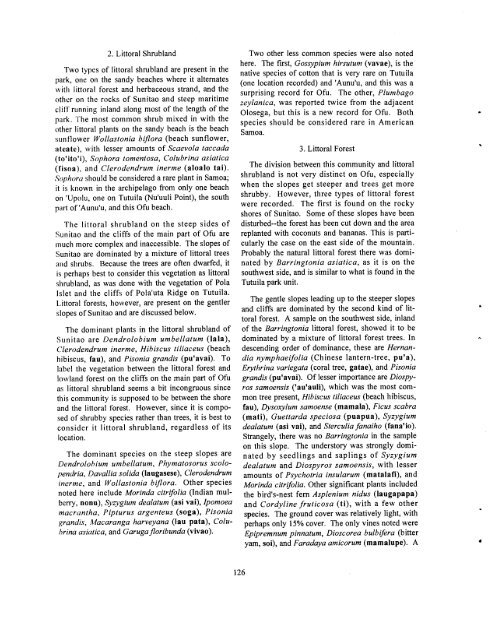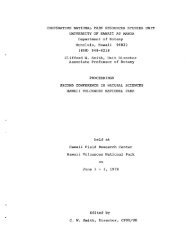american samoa - University of Hawaii at Manoa
american samoa - University of Hawaii at Manoa
american samoa - University of Hawaii at Manoa
You also want an ePaper? Increase the reach of your titles
YUMPU automatically turns print PDFs into web optimized ePapers that Google loves.
2. Littoral Shrubland<br />
Two types <strong>of</strong> littoral shrubland are present in the<br />
park, one on the sandy beaches where it altern<strong>at</strong>es<br />
with littoral forest and herbaceous strand, and the<br />
other on the rocks <strong>of</strong> Sunitao and steep maritime<br />
cliff running inland along most <strong>of</strong> the length <strong>of</strong> the<br />
park. The most common shrub mixed in with the<br />
other littoral plants on the sandy beach is the beach<br />
sunflower Wollastonia bijlora (beach sunflower,<br />
sk<strong>at</strong>e), with lesser amounts <strong>of</strong> Scaevola taccada<br />
(to'ito'i), Sophora tomentosa, Colubrina asi<strong>at</strong>ica<br />
(fisoa), and Clerodendrum inerme (aloalo tai).<br />
Sophora should be considered a rare plant in Samoa;<br />
it is known in the archipelago from only one beach<br />
on 'Upolu, one on Tutuila (Nu'uuli Point), the south<br />
part <strong>of</strong> 'Aunu'u, and this Ofu beach.<br />
The littoral shrubland on the steep sides <strong>of</strong><br />
Sunitao and the cliffs <strong>of</strong> the main part <strong>of</strong> Ofu are<br />
much more complex and inaccessible. The slopes <strong>of</strong><br />
Sunitao are domin<strong>at</strong>ed by a mixture <strong>of</strong> littoral trees<br />
and shrubs. Because the trees are <strong>of</strong>ten dwarfed, it<br />
is perhaps best to consider this veget<strong>at</strong>ion as littoral<br />
shrubland, as was done with the veget<strong>at</strong>ion <strong>of</strong> Pola<br />
Islet and the cliffs <strong>of</strong> Pola'uta Ridge on Tutuila.<br />
Littoral forests, however, are present on the gentler<br />
slopes <strong>of</strong> Sunitao and are discussed below.<br />
The dominant plants in the littoral shrubland <strong>of</strong><br />
Sun itao are Dendrolobium umbell<strong>at</strong>um (lala),<br />
Clerodendrum inerme, Hibiscus tiliaceus (beach<br />
hibiscus, fau), and Pisonia grandis (pu'avai). To<br />
label the veget<strong>at</strong>ion between the littoral forest and<br />
lowland forest on the cliffs on the main part <strong>of</strong> Ofu<br />
as littoral shrubland seems a bit incongruous since<br />
this community is supposed to be between the shore<br />
and the littoral forest. However, since it is compo-<br />
sed <strong>of</strong> shrubby species r<strong>at</strong>her than trees, it is best to<br />
consider it littoral shrubland, regardless <strong>of</strong> its<br />
loc<strong>at</strong>ion.<br />
The dominant species on the steep slopes are<br />
Dendrolohium umbell<strong>at</strong>um, Phym<strong>at</strong>osorus scolo-<br />
pendria, Davallia solida (laugasese), Clerodendrum<br />
inerme, and Wollastonia bipora. Other species<br />
noted here include Morinda citrifolia (Indian mul-<br />
berry, nonu), Syzygium deal<strong>at</strong>um (asi vai), Ipomoea<br />
macrantha, Pipturus argenteus (soga), Pisonia<br />
grandis, Macaranga harveyana (lau p<strong>at</strong>a), Colu-<br />
hrina asiafica, and GarugafIoribunda (vivao).<br />
Two other less common species were also noted<br />
here. The first, Gossypium hirsutum (vavae), is the<br />
n<strong>at</strong>ive species <strong>of</strong> cotton th<strong>at</strong> is very rare on Tutuila<br />
(one loc<strong>at</strong>ion recorded) and 'Aunu'u, and this was a<br />
surprising record for Ofu. The other, Plumbago<br />
zeylanica, was reported twice from the adjacent<br />
Olosega, but this is a new record for Ofu. Both<br />
species should be considered rare in American<br />
Samoa.<br />
3. Littoral Forest<br />
The division between this community and littoral<br />
shrubland is not very distinct on Ofu, especially<br />
when the slopes get steeper and trees get more<br />
shrubby. However, three types <strong>of</strong> littoral forest<br />
were recorded. The first is found on the rocky<br />
shores <strong>of</strong> Sunitao. Some <strong>of</strong> these slopes have been<br />
disturbed--the forest has been cut down and the area<br />
replanted with coconuts and bananas. This is parti-<br />
cularly the case on the east side <strong>of</strong> the mountain.<br />
Probably the n<strong>at</strong>ural littoral forest there was domi-<br />
n<strong>at</strong>ed by Barringtonia asi<strong>at</strong>ica, as it is on the<br />
southwest side, and is similar to wh<strong>at</strong> is found in the<br />
Tutuila park unit.<br />
The gentle slopes leading up to the steeper slopes<br />
and cliffs are domin<strong>at</strong>ed by the second kind <strong>of</strong> lit-<br />
toral forest. A sample on the southwest side, inland<br />
<strong>of</strong> the Barringtonia littoral forest, showed it to be<br />
domin<strong>at</strong>ed by a mixture <strong>of</strong> littoral forest trees. In<br />
descending order <strong>of</strong> dominance, these are Hernan-<br />
dia nymphaeifolia (Chinese lantern-tree, pu'a),<br />
Erythrina varieg<strong>at</strong>a (coral tree, g<strong>at</strong>ae), and Pisonia<br />
grandis (pu'avai). Of lesser importance are Diospy-<br />
ros samoensis ('au'auli), which was the most com-<br />
mon tree present, Hibiscus tiliaceus (beach hibiscus,<br />
fau), Dysoxylum samoense (mamala), Ficus scabra<br />
(ma ti), Guettarda speciosa (pua pua), Syzygium<br />
deal<strong>at</strong>um (asi vai), and Sterculia fanaiko (fana'io).<br />
Strangely, there was no Barringtonia in the sample<br />
on this slope. The understory was strongly domi-<br />
n<strong>at</strong>ed by seedlings and saplings <strong>of</strong> Syzygium<br />
deal<strong>at</strong>um and Diospyros samoensis, with lesser<br />
amounts <strong>of</strong> Psychotria insularum (m<strong>at</strong>alafi), and<br />
Morinda citrifolia. Other significant plants included<br />
the bird's-nest fern Asplenium nidus (laugapapa)<br />
and Cordyline fruticosa (ti), with a few other<br />
species. The ground cover was rel<strong>at</strong>ively light, with<br />
perhaps only 15% cover. The only vines noted were<br />
Epipremnum pinn<strong>at</strong>um, Dioscorea bulbifera (bitter<br />
yam, soi), and Faradaya amicorum (mamalupe). A
















